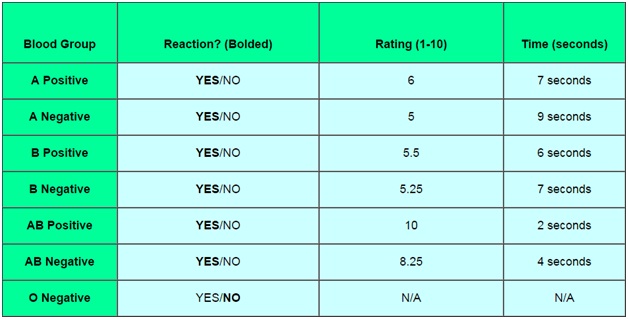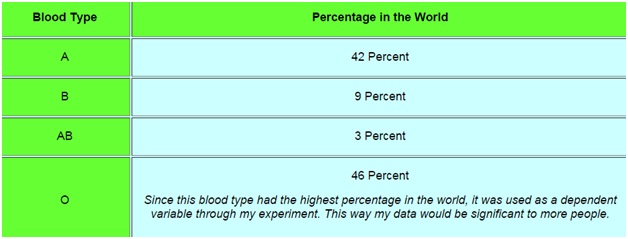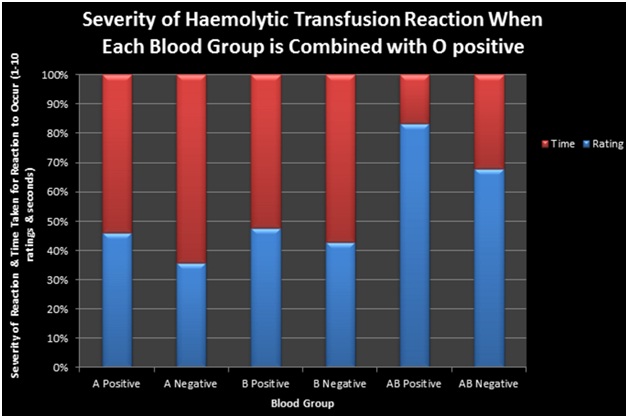





Published on Sep 12, 2023
A thorough experiment investigating the major components of and within the human blood, and using it to peak at the side effects of specific haemolytic transfusion reactions. These reactions were tested by combining all major blood groups with O Positive, in order to find the agglutination (or clumping) levels, as well as how long it took for the reaction to occur, within different blood types. These results were thoroughly analyzed, and furthermore contrasted, using several books and other reliable resources, in order to come to a detailed conclusion on why and how these results came to be. Learning about several other blood disorders, as well as the immune system, heart, and relevant issues today, this experiment is sure to astonish you with its many practical applications, and knowledgeable foundation
A haemolytic transfusion reaction occurs when there is a matching antigen and antibody type in your blood. As you can see to the right, this reaction can lead to agglutination in your blood vessels, therefore restricting blood flow. This will have fatal consequences. In this experiment, I will determine the effect when each blood group is mixed with O positive , and compare whether the haemolytic transfusion reaction varies in accordance to the blood type mixed (For example, A negative + O positive VS. B positive + O positive).
Depending on the result, particular blood disorders and causes can be easily identified within different types of people, victims will be able to understand the precautions and risks they may face when receiving a blood transfusion, and developing countries can be further educated in medical technology and research. This can encourage a lower death rate in most countries, and promote a healthy lifestyle for everyone. Moreover, this experiment will determine how long it takes for a reaction to occur within the human body, if a blood transfusion goes wrong, to effectively compare severity levels between various blood types.
If I change the blood type, and presence of the Rh antigen (to make the blood groups positive or negative), in combination with the blood type O positive, what will happen to the severity of the haemolytic transfusion reaction the victim may encounter?
Well, I predict that if the A and B antibody, located in the plasma of the O victim`s blood, will be combined with both the A and B antigen, located on the surface of the red blood cells, of the donors blood (group AB), then the haemolytic transfusion reaction will be the most severe amongst all blood types.
I expect that this will happen because of several significant factors relating the composition of blood in the body. Primarily, each of the antigens, when combined with their matching antibody will immediately agglutinate and generate clumps in the body, thereby restricting blood flow. I perceive that if only the A or B blood group is mixed with O Positive recipient’s blood, the haemolytic transfusion reaction will be only half as severe, as only one of the two possible antigens is able to combine with the identical antibody. As we know, the AB positive blood group has all of the possible antigens (A, B, Rh), and the O Positive blood group has both of the antibodies (A and B). Karl Landsteiner, the founder of blood groups, has also determined that antigens and antibodies bind when similar types are present within the blood stream, therefore supporting my prediction that the mixture of AB Positive and O Positive, to be the most severe, amongst all.
Materials that were used in this project can be costly, but luckily you have two options - buy the materials OR... find out the staggering results right here on this web! Both are equal, just one is more time consuming. Either way its good to know what materials I used, or what you could use, to better understand the meaning of the results obtained, and witness for yourself how accurate they really are!
Carolina ABO Rh Blood Typing with Synthetic Blood Kit … #1-$43.95
Mixing Sticks … #12
Synthetic Anti A Serum … #1
Synthetic Anti B Serum … #1
Synthetic Anti Rh Serum … #1
Blood Typing Slides … #4
Blood Samples (A ,B, O, Rh) … #4 [1 of each]
Safety Goggles … #1 - $5.00
Apron … #1 - $2.00
Magnifying Glass … #1 - $10.00
Safety Gloves … #1 - $1.00
In this tab you will discover the observations that I recorded throughout my experiment, in two forms – tables & graphs. Select the type of observations you would like to see below, and you will be shown the results in the type of form you have chosen. There is more than one table or graph. You can select the next or previous button(s) to see more information in the format you specified. If you would like to return to this page you can do so by clicking the “Observations” link in the Navigational Guide, or the “Back” button on the slide you are already in. This way, you can see both types of data at your leisure. Hope you enjoy, while investigating the formation of your blood stream, and how it protects itself.



Well, when I changed the blood type, and presence or absence of the Rh antigen (to make a blood group positive or negative), in combination with the blood group O positive, I discovered that the haemolytic reaction was higher when the blood group had more antigens, as well as the Rh antibody. Therefore, when the blood group AB positive was combined with O positive, the reaction was the strongest, and occurred within the smallest amount of time. In addition, I discovered that when the reaction was severe, it took less time for the blood to agglutinate, then when the reaction between the antigens and antibodies were weak.
For example, when the blood group AB positive was combined with O positive, the reaction level was ten and the time taken was only two seconds; however, when the blood group A negative was combined, the reaction level was a meagre five, yet the time taken for the blood cells to agglutinate was nine seconds! Therefore, the data supports my hypothesis made before the commencement of this experiment, and I accept my prediction.
American Society of Hematology. "Journal of the American Society of Hematology." Comp. Brian Cannon. Blood (n.d.): n. pag. Blood. American Society of Hematology. Web. 12 Apr. 2013. <http://bloodjournal.hematologylibrary.org/>.
Ballard, Carol. Heart and Bood: Inquiry, Ilness, Health
Illinois: Heinemann, 2003. Print.
Encyclopedia of Health. New York: Marshall Cavendish, 2003. Print.
Gaensslen, R. E., Henry C. Lee, Elaine M. Pagliaro, and Julie K. Bremser. Procedures and Evaluation of Antisera for the Typing of Antigens in Bloodstains: ABH, Rh, MNSs, Kell, Duffy, and Kidd Blood Group Antigens and Gm./Km Serum Group Antigens. Washington, D.C.: U.S. Dept. of Justice, National Institute of Justice, 1984. Print.